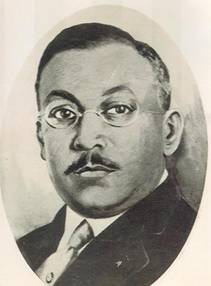
No educator left a more indelible mark on the University of Maryland Eastern Shore in its first half-century than Thomas Henry Kiah.
- He is the first Eastern Shore and Maryland native to head the institution.
- He is the first alumnus to be its chief executive.
- He held the post for 26 years, the longest tenure in the school’s first 125 years.
- His name adorned two campus buildings.
Kiah was born April 14, 1873 to Adelia and William Kiah on a Dorchester County farm not far from Bucktown, birthplace of Underground Railroad conductor Harriet Tubman.
Kiah and his identical twin, James Albert, attended Christ Rock elementary school affiliated with the local Methodist Episcopal Church. At age 17, he was licensed to preach and “sent to pastor” a church in the Oakville community just east of Princess Anne.1
Desiring to further his education, Thomas enrolled in Princess Anne Academy to complete his secondary education. After his 1900 graduation, Kiah entered Morgan College in Baltimore, where his faith grew and his calling for the ministry deepened. While at Morgan, he accepted a summer appointment at a church in Ocean City, N.J.1
Kiah graduated from Morgan on June 4, 19032 and joined the Methodist Episcopal Church’s Delaware Conference, where his brother also was a pastor. The conference assigned Thomas Kiah to pastor the Union Methodist Episcopal Church in St. Michaels, Md.
With a college degree in hand and a new job, Kiah married Mary Roberta Townsend, a 1898 Princess Anne Academy alumna and a minister’s daughter, in a ceremony performed June 27, 1906 in Baltimore by the Rev. Noah T. Moore, a family friend. In light of his qualifications and deportment, Kiah soon found himself accepting an appointment to be principal of his alma mater, where he succeeded Frank Trigg in 1910.

McQuay Randolph held by Mary Roberta Kiah,
Rodelia Loyola and Thomas Henry Kiah; c. 1917
The Kiahs were devoted to Princess Anne Academy, and both worked to advance the institution. During their 13-year marriage, they had six children: Calvin Lycurgus, Thomas Waldo, Hamilton Gregory, Alphonso Brewington, Rodelia Loyola and McQuay Randolph.
Kiah was determined to help Blacks pursue education and equality. A lifelong learner, he received his Master of Arts degree in 1916 from Wiley University, Marshall, Texas.
Two years after the Oct. 7, 1918 death of his wife, Mary Roberta, Kiah earned a doctorate of pedagogy from Morgan. He also did graduate studies at Cornell and Columbia universities.
In June 1921, Kiah married Cynthia Ola Powdrill. A 1915 graduate of Hampton Institute, the 28-year-old originally from Ashton, Kansas3 was a nurse at Dixie Hospital in Hampton, Va. They had five children: Cynthia O., Thomas Henry, Jr., Humphrey Powdrill, Gwendolyn Carmen and Grace Winona.
Kiah, the academy’s fifth leader, distinguished himself in the ministry, as an educator and in the community at-large.
“It was his preaching that (Principal) Kiah found the fullest scope for the exercise of all his varied powers. His sermons were always the reflex of his own broad and generous nature, fair and stately, in form and vivified by an ever fresh supply of spiritual life,”1 his obituary said.
“He was deferential to the feelings of those about him, and was incapable of cherishing ill toward anyone. Faculty, students and the general public alike felt the charm of this superior mind.1“
A 33rd degree Mason, Kiah was elected Deputy Grand Master of the Free and Accepted Masons for the Maryland jurisdiction on Aug. 15, 1927. At a March 20, 1932 Masonic program held in his honor, a peer described Kiah as a quiet and unassuming individual who won the confidence and respect of all with whom he comes in contact.
During his tenure as principal, the academy’s enrollment fluctuated and its curriculum expanded to prepare students for the new realities of America’s growing society.
He is widely credited with laying the groundwork that resulted in the academy evolving from high school-level work into an institution of higher education
A diabetic, Kiah suffered burns in a Christmas Day accident in his home, which resulted in infection.4 He died Dec. 30, 1936 in nearby Salisbury, and is interred alongside Mary Roberta in the campus cemetery. Four of his sons sang during the four-hour funeral held Jan. 5, 1937 at Metropolitan Methodist Episcopal Church just west of campus.5
Two years after his death, Black Masons in Chestertown, Md. named their lodge after him in recognition of his life’s work as an educator who championed the cause of teaching Blacks.
A gymnasium-auditorium, constructed with federal Works Progress / Projects Administration money and completed in 1940, was named in Kiah’s honor. The 1940 U.S. census for Princess Anne listed his wife Cynthia employed as a nurse at what had been renamed Princess Anne College, living with six of the couple’s children as well as a granddaughter.
The gym eventually outlived its usefulness and was torn down to make way for Hazel Hall, a classroom building. His memory remains preserved in brick and mortar not far away, however, where Kiah Hall is a classroom building originally constructed in the early 1950s as a segregated public middle and high school.
1 – Delaware Annual Conference – Methodist Episcopal Church, 74th session official journal and yearbook, March 1937; pgs. 109-110.
2 – The Baltimore Sun, June 5, 1903, pg. 8.
3 – The Native American magazine, May 15, 1915, pg. 237.
4 – The Salisbury Times, Dec. 31, 1936; pg. 8.
5 – The Afro-American, Jan. 9, 1937; pg. 9.

